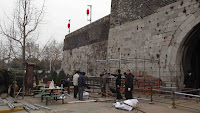It turns out that Mr Hu finds you. As our bus arrived into Tangkou, Mr Hu pulled up in his ride and ferried us to his lovely (but ridiculously cold - no radiators remember) hotel. He insisted that he just happened to be passing by when he saw us, but I put it down to some kind of sixth sense. Or perhaps the bus driver gave him a heads up. Either way, according to the guest book at Mr Hu's Hotel, he seems to enjoy a monopoly over foreign visitors.
In his defence, you can see why. He speaks English, his hotel is cheap, his wife cooks great food, he's incredibly knowledgeable about Mount Huangshan (after 30 years of working as a guide), his guests can enjoy discount entry to the nearby attractions, he'll help book accommodation on top of the mountain and he'll even arrange tickets for a bus or train out of there. Seriously, if you ever go there, look him up. Here's a link to (fellow ELA) Priya's excellent blog which has a picture of the great man. Oh and the wonderful "English Breakfast" they served at his hotel.
We all agreed that the best way to spend our first afternoon in the mountains would be to visit the hot springs. I think we spent about 5 hours floating around in the pools. It was glorious. Until you had to get out.
On our second day we decided to walk up the lower half of the mountain before getting a cable car to the top where we would stay one night. It was a cold day so we made sure we were nicely layered up. Two minutes in and we had all stripped down to our t-shirts. Climbing up steps is hard work.
As the Spring Festival holiday had not yet begun we had the path to ourselves as it wound passed waterfalls and through lush bamboo forests. We didn't even have to queue for the cable car which took us up to the peak of the mountain where a white, winter wonderland was waiting for us.
Although it was fun to play in the snow (for about a minute), we quickly realised that the snowy, misty and foggy weather would not allow us to experience any of the spectacular views that the mountain is renowned for. We did encounter a wild monkey though. It was terrifying.
There are a few hotels on the top of the mountain. Naturally we stayed in the cheapest. £10 for a dorm room bed. The next morning a few of us decided to walk down the mountain. It was cold, wet, slippery and steep but it did allow us to briefly glimpse some beautiful views of distant peaks poking out from the sea of cloud below.
Whilst stumbling and struggling down the stairs we were frequently passed by Chinese porters who were practically running up the hill with supplies for the guests at the top of the mountain. They would carry huge loads on their backs whilst wearing little more than plimsolls on their feet. It was quite an incredible sight but unfortunately I didn't take a photo so here's one I found online.
Mount Huangshan is definitely worth a visit and if you get lucky with the weather, the views will be absolutely incredible. Recommend staying with Mr Hu, climbing the mountain with one or two nights on the top before climbing down and visiting the hot springs to relax and rest your weary legs.
Next stop, Hangzhou.

























